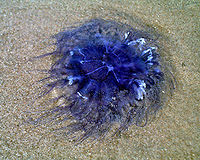- Blue jellyfish
-
Cyanea lamarckii 
Scientific classification 
Kingdom: Animalia Phylum: Cnidaria Subphylum: Medusozoa Class: Scyphozoa Order: Semaeostomeae Family: Cyaneidae Genus: Cyanea Species: C. lamarckii Binomial name Cyanea lamarckii
Péron & Lesueur, 1810Cyanea lamarckii, also known as the Blue jellyfish or Bluefire jellyfish, is a species of jellyfish in the family Cyaneidae. Populations in the western Pacific around Japan are sometimes distinguished as Cyanea nozakii or Cyanea capillata nozakii.
Contents
Distribution
This species is found in the pelagic zone off the west coast of Scotland, the North Sea and the Irish Sea, sometimes with the more common Lion's Mane Jellyfish, (Cyanea capillata).[1]
Description
Cyanea lamarckii has a blue or yellow tone and grows to approximately 10 to 20 cm, but specimens can grow to 30 cm.[2] In Scandinavian seas this species rarely grows larger than 15 cm.
This jellyfish has many stinging tentacles. The four mouth arms are large with many wrinkles and ripples.[3]
Taxonomy
The taxonomy of Cyanea species is not fully agreed upon. Some zoologists have suggested that all species within the genus should be treated as one. However, Cyanea lamarckii exists with two other distinct taxa in at least the eastern North Atlantic.
The species specifyer originates from the French naturalist Lamarck (Latin name form: Lamarckius).
Life cycle
The medusae bud and loosen from the mature polyps between January and March around the British Isles and southern North Sea. This occurs in a similar way to the life cycle of the moon jellyfish.
References
- ^ Andy Horton. "British Jellyfish". Glaucus.org.uk. http://www.glaucus.org.uk/Jelly.htm. Retrieved 2010-07-30.
- ^ "Blue jellyfish (Cyanea lamarckii):: OS grid SN6090 :: Geograph Britain and Ireland - photograph every grid square!". Geograph.org.uk. http://www.geograph.org.uk/photo/532228. Retrieved 2010-07-30.
- ^ "Aquascope|Facts|Blå brännmanet". Vattenkikaren.gu.se. http://www.vattenkikaren.gu.se/fakta/arter/cnidaria/scyphozo/cyanlama/cyanlae.html. Retrieved 2010-07-30.
Further reading
Howson, C.M.; Picton, B.E. (Ed.) (1997). The species directory of the marine fauna and flora of the British Isles and surrounding seas. Ulster Museum Publication, 276. The Ulster Museum: Belfast, UK. ISBN 0-948150-06-8. vi, 508
Muller, Y. (2004). Faune et flore du littoral du Nord, du Pas-de-Calais et de la Belgique: inventaire. [Coastal fauna and flora of the Nord, Pas-de-Calais and Belgium: inventory]. Commission Régionale de Biologie Région Nord Pas-de-Calais: France. 307 pp.
Cornelius, P.F.S. (2001). Cubozoa, in: Costello, M.J. et al. (Ed.) (2001). European register of marine species: a check-list of the marine species in Europe and a bibliography of guides to their identification. Collection Patrimoines Naturels, 50: pp. 111
Categories:
Wikimedia Foundation. 2010.
